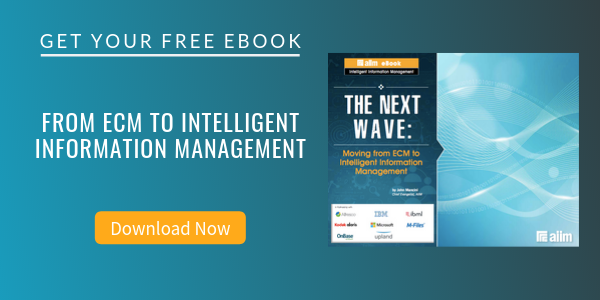.jpg)
How Do We Focus the C-Suite on ECM (or Do We Need to Change Our Tune)?
Enterprise Content Management (ECM)
I recently had a conversation with outgoing AIIM board member Michael Croal (Cornerstone Advisors). I thought I would capture the core of it in this blog post. I think there is a lot of meat here regarding the industry and how we sell and position content-centric solutions.
JM: Michael, you recently sent me a 22-page framework going through a huge taxonomy of processes in banking. Tell me a little about how this would go over with the C-suite?
MC: From a practical standpoint, I doubt a C-level would get past page 1 of the 22-page framework. Core processes are what businesses do every day to create value; these are the processes that create value that the customer will pay for, which is the only way businesses make money. In banking, there are and always have been just six core processes that are the focus of the c-suite:
- New Customer/New Account: Sale to 1st Anniversary
- Consumer Loan Delivery: Application to Lien Perfection
- Mortgage Loan Delivery: Lead to Investor Sale
- Commercial Loan Delivery: Expression of Interest to Annual Review
- Collections: Past Due to Current
- Loan Servicing: Boarding to Collateral Release
Unless you can tie what you are selling to help solve one of these problems, you are wasting your time.
JM: Why are these processes so difficult to get right?
MC: Every C-level in a bank recognizes that these six processes are critical to performance, yet very few banks/credit unions have senior-level managers with these end-to-end processes as their sole responsibility.
These processes are typically broken up into Origination, Underwriting, Processing, Closing, and Servicing. That means five different silos with five different systems. Each silo may go after new and changing technologies, but there is no coordination among all of the various technologies in play in the organization -- whether it’s ECM, Business Intelligence, CRM, or ERP -- and the end result is the chaos. The C-suite needs to understand that the root of their info chaos and under-performance is because of too many hands in the process design pie.
JM: Here at AIIM, we often talk about how difficult it is to get strategic visibility for content management. Why do you think that is?
MC: The lack of process owners who are responsible for designing, building, enhancing high performing processes (as opposed to worrying about financial results, budget variances, expense reduction programs, etc.) is why the ECM message is reaching the practitioners but having such a difficult time reaching the C-suite.
Let me go a bit deeper on just one of the processes I mentioned earlier -- New Customer/New Account: Sale to 1st Anniversary -- to give you an idea of the challenge.The process picks up after marketing and product development have decided what the products and fees are, and the customer has made the choice for the free checking account with online banking, bill-pay, e-statements, mobile banking, and a debit card.
Today, there is someone responsible for the platform system that generates the paperwork and signature card; someone else has responsibility for online banking and maybe includes mobile banking. Another AVP owns debit cards, and another owns statement production. Buried in the process is compliance, and yet another someone who owns the “Know Your Customer and AntiMoney Laundering” process.
Finally, someone in Retail might own the customer onboarding program that requires the process performers to contact the customer two days after the account is opened to make sure the debit card is working, two weeks later to see that the check order arrived, and two months after that to make sure things are alright. This retail person may also have a metric of cross-sells or wallet share but lacks access to online banking and bill pay activity to see that the customer also pays another financial institution $2,300 on the 3rd day of every month, and hence does not know that a lead should be generated for the mortgage group to begin their process of Mortgage Loan Delivery: Lead to Investor Sale.
A root cause of all this chaos is the subdivision of a broad process “flow” into small tasks, each with a different owner -- and usually a different platform.
JM: Do you see this as just a bank problem, or something more universal?
MC: In other verticals, I have to assume their core processes have not changed in the last 100 years either. If I had to guess at some, they would be:
- Healthcare:
- Patient Tracking: Admission to Discharge
- Patient Billing: Service/Supply to Bill Satisfaction
- Patient Surgery: Diagnoses to Follow-up
- Energy:
- New Production: Land Acquisition to 1st Barrel
- Refining: Raw Material to Final Product
- Insurance:
- Claims Adjustment: Initial Contact to Final Resolution
- New Policy: Request for Quote to Renewal
I’m sure each of these processes has been broken down and fragmented into simple tasks rife with redundant data entry, checkers checking the checkers, and multiple copies of records in email, share drives, and ECM and BPM. The glue that puts all of these activities back together into a complex, bulky, inefficient process is called middle management, and middle management doesn’t have the clout to fix it.
About John Mancini
John Mancini is the President of Content Results, LLC and the Past President of AIIM. He is a well-known author, speaker, and advisor on information management, digital transformation and intelligent automation. John is a frequent keynote speaker and author of more than 30 eBooks on a variety of topics. He can be found on Twitter, LinkedIn and Facebook as jmancini77. Recent keynote topics include: The Stairway to Digital Transformation Navigating Disruptive Waters — 4 Things You Need to Know to Build Your Digital Transformation Strategy Getting Ahead of the Digital Transformation Curve Viewing Information Management Through a New Lens Digital Disruption: 6 Strategies to Avoid Being “Blockbustered” Specialties: Keynote speaker and writer on AI, RPA, intelligent Information Management, Intelligent Automation and Digital Transformation. Consensus-building with Boards to create strategic focus, action, and accountability. Extensive public speaking and public relations work Conversant and experienced in major technology issues and trends. Expert on inbound and content marketing, particularly in an association environment and on the Hubspot platform. John is a Phi Beta Kappa graduate of the College of William and Mary, and holds an M.A. in Public Policy from the Woodrow Wilson School at Princeton University.



